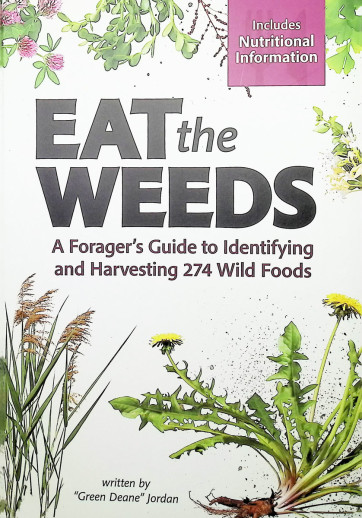We use cookies to make your experience better. To comply with the new e-Privacy directive, we need to ask for your consent to set the cookies. Learn more.
Eat the Weeds
Whether you have dreams of going “off-grid” or just enjoy hiking and want to learn more about foraging, you’ll love this guide by “Green Deane” Jordan! With a focus on North American plants (though many originated from around the world), it’s packed with information about and clear pictures of 274 plants, alphabetically organized and easy to use. The front section provides detailed information on basic plant anatomy with diagrams to help identify specific types of leaves, flowers, fruit, and roots, as well as foraging safety, common mistakes, information on toxic plants, and recommended survival foods. Each individual plant has an itemized profile with a picture; safety notes; identification tips; the season, geographic range, and environment where it grows; nutritional data; how to prepare it; and Deane’s personal notes, which are super helpful. Such a great resource to help you find, identify, and harvest wild food!
Forage all across the country with this informative guide to 274 edible plants, presented by expert Green Deane.
Eating wild edibles is in our genes, and it can be healthy fun! It’s seasonal, sufficient, varied, and provides plenty of nutrients. It yields the satisfaction born of food independence and competence. There’s no packaging, no labeling, no advertising, and no genetic tinkering involved. But which plants should you eat—and when should you eat them?
Let “Green Deane” Jordan guide you with Eat the Weeds. Green Deane teaches foraging classes and runs a popular foraging website (also called Eat the Weeds). Now he’s sharing his expertise with you. Eat the Weeds presents 274 wild foods and helps you to find, identify, and harvest them. The book begins with an introduction that includes tips for using this comprehensive book. The weeds are organized alphabetically, and an extensive index further helps you find what you’re looking for. Plus, a fascinating and informative table aids in choosing plants based on their notable nutrients!
Perhaps you recognize a shortage in your diet of a specific vitamin and/or mineral. This guide points you to the plants that could remedy it. The information appeals to everyone from foragers, gardeners, and nature-lovers to raw food enthusiasts, vegans, and survivalists. Each entry includes an introduction to the plant and recommended methods for preparing it, as well as its nutritional information. Yes, nearly every featured wild edible includes a full nutrition table! Color photographs and visual descriptions assist you in field identification, and Green Deane’s insights are invaluable, whether you’re a beginning forager or someone with plenty of experience.
Foraging is a treasure hunt, so eat healthier, save money, and have fun while enjoying Earth’s delicious and nutritious bounty.
| Product Format: | Paperback |
|---|---|
| Brand: | Adventure Publications |
| Grades: | 9-AD |
| ISBN: | 9781647551797 |
| Length in Inches: | 9.1875 |
| Width in Inches: | 6.25 |
| Height in Inches: | 0.8125 |
| Weight in Pounds: | 1.3 |

